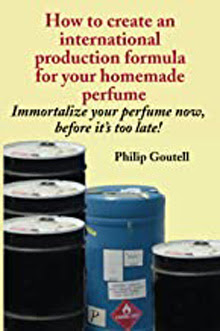This blog was inspired by my own work in perfumery which started with the PerfumersWorld Foundation Course, a home study course in creative perfumery which I began in 2005 and which, thanks to my relationship with PerfumersWorld, I now sell at my PerfumeProjects website.
The starting point in the Foundation Course is a set of 25 perfume bases and one non-alcoholic solvent representing the letters "A" through "Z" in the "ABC's of Perfumery" teaching method developed by perfumer Stephen V. Dowthwaite, founder of PerfumersWorld. Using nothing more than these 25 bases, you can "match" a very wide variety of fragrances and fragrance types -- IF you give your nose a bit of training. More important, you can imagine -- and create -- excellent, original perfumes of your own.
Now, while finishing my final adjustments on a men's cologne (Blackberry), I've returned to a woman's fragrance I started last summer. For reasons I'll explain in another post, I've called it Pink Gardenia.
Blackberry was inspired by a black currant base from PerfumersWorld but the formula itself makes use of both a number of essential oils and synthetic aroma chemicals. In fact, the black currant "inspiration note" is the only base I used for this fragrance and it includes none of the "A-Z" Foundation Course bases.
Like Blackberry, Pink Gardenia was inspired by a PerfumersWorld base, "Gardenia Fleuressence." But for Pink Gardenia I decorated, modified, and enhanced the gardenia base using, almost exclusively, bases from my original K-26 Foundation Course materials kit. In fact, of the aroma materials I ultimately selected for Pink Gardenia, only three were single note synthetic aroma chemicals and one of those was simply a swap for a K-26 kit base that I made because my substitution, an aroma material I had used frequently in the past, had "bell sound" (to my nose!) rather than the "gentle melody" of the K-26 base material I had first used in this formula.
Pink Gardenia isn't the first perfume I designed using the K-26 kit bases almost exclusively. Code Name 'Paris' is another example of a sophisticated perfume built almost exclusively from these "simple" aroma bases.
Building a sophisticated perfume using nothing more than 25 bases plus the gardenia base (which is not part of the K-26 kit), may seem a bit simplistic. You can't imaging Estee Lauder's perfumers limiting themselves to just 25 bases to sketch out a fragrance such as Sean John's Unforgivable. BUT here's where the tools in the Foundation Course get really interesting. The course comes with a computer program -- The Perfumers Workbook -- which gives you the power to add enormous sophistication to your fragrances by introducing you to aroma materials that are likely to be entirely new to you.
In the case of Pink Gardenia, I did not make use of this incredibly useful tool. Why? Because my goal was to create a pleasant, simple fragrance, and that's exactly what I had when I finished my original formula. But, had I not been so pleased with what I had created ("If it ain't broke, don't fix it!"), this is what I would have done --
Using The Perfumers Workbook, I would first enter my formula for Pink Gardenia. Then, for each of the K-26 kit bases I had used, I would ask the software to suggest substitutes -- essential oils and/or synthetic aroma chemicals that I might use as substitutes or supplements for each particular base.
Then -- the ultimate "professional" touch -- I would ask the software what I might do to give the formula more complexity and depth. In a few seconds the screen would spit out a formula of its own -- a modification of my formula -- adding small quantities of many aroma materials which, for the most part, would be totally new to me.
Most of the computer's suggestions would be for materials I would not have on hand. This isn't as big a problem as you might imagine. The software allows you to review each of the materials to get an idea of their aroma and characteristics, just by looking at your computer screen. Only when I see a new aroma material that I believe could enhance the aroma or smooth over a rough spot would I start to worry about how and where to obtain a supply.
In fact, most of the materials suggested by the software can be purchased from PerfumersWorld in small, affordable, quantities. And, as you begin to develop your "library" or aroma materials, you learn of other reliable sources, some of which may be more convenient for you. So, if the computer is showing me some new aroma materials that might improve my formula, I'll try to obtain a small supply of those materials and play with them a bit, to see if any of them are helpful. Of course all of this will be detailed in my notebook.
Pink Gardenia came together for me a lot faster than some other perfumes I've worked on (some of which just ended up in the sink!) But, when your nose tells you that you've got what you've been seeking, it's time to stop developing and start bottling ... and start marketing!
Tuesday, December 16, 2008
Subscribe to:
Post Comments (Atom)


No comments:
Post a Comment